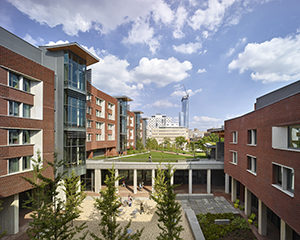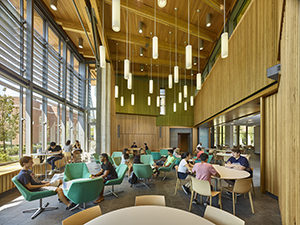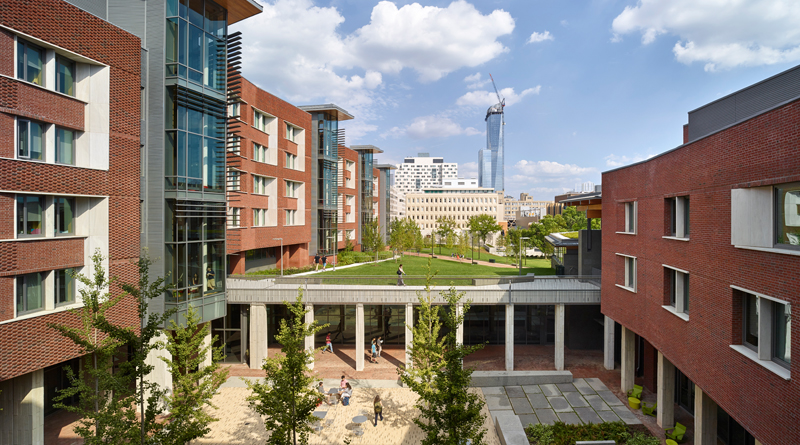A Living-Learning Residence
By Jessie Fetterling
PHILADELPHIA — The New College House at the University of Pennsylvania (Penn) in Philadelphia emphasizes both living and learning, bringing together students, faculty and staff into a shared suite-style community. This living-learning community concept pairs perfectly with the facility’s open, transparent design that is on track to achieve at least LEED Silver.

The New College House opened in time for the 2016-17 academic year and has quickly become a major part of campus life with its prime location at one of the university’s entrances. The 198,000-square-foot, 350-bed building is the first new student residence built on the campus since 1972. It features comfortable student rooms collected in three- to six-person suites with access to study areas, a media center, open communal spaces, seminar rooms, a dining café and an enclosed courtyard. Bohlin Cywinski Jackson (BCJ) served as the architect on the project, while INTECH Construction was the construction manager — both of which are based locally.
“In this city of neighborhoods, we sought to embrace the many scales of community that define the collegiate experience unique to Penn,” said Frank Grauman, design principal with BCJ, in a statement. “The New College House is, therefore, both inviting and secure, open and private, embodying the comfort of home and the power to form a campus gateway worthy of this place.”
A Learning-Living Community
Purposely built as a learning-living community, the building functions to bring all members of the campus community together. That starts with everyone having the same entrance, which not only makes sense for security purposes, but also creates the community-centric idea that everyone comes home through the same front door.
“Student life and community connection is represented throughout New College House’s design: On the exterior, the scale of the building is balanced with the surrounding structures, while anchored as an inviting campus gateway,” said Sam McNutt, architect for BCJ, in a statement. “On the interior, common areas offer spaces for large group events while smaller, more intimate spaces allow for private study.”
The dining component includes a lot of amenity features that bring students together. In fact, there are two community kitchens — one of which is associated with a lounge — for students to reserve and cook in themselves. Along with the kitchen spaces and dining hall — designed to accommodate half of the building occupants in one seating — there are also a living room with a fireplace, a media room with a television, and music practice room available for students to mix and mingle.
Transparency & Sustainability

Photo Credit (all): Jeffery Totaro
While the design of the new facility takes cues from some of the older campus buildings — integrating elements such as the Eero Saarinen-designed Hill College House’s brick and the law school’s limestone — it uses significantly more glass to bring in natural light and create transparency. A curtainwall, windows and sun shades from Wausau, Wis.-based Wausau Window and Wall Systems helped provide that necessary balance of natural light throughout the interiors.
As both INTECH and BCJ had worked with Wausau on other projects across UPenn’s campus, the two firms decided to again use the company to provide the curtainwall and window systems, this time in conjunction with Horsham, Pa.-based National Glass & Metal as the glazing contractor. This started the design-assist process, which allowed Wausau to work with the design team to get the desired look and specified performance, while keeping the window and curtainwall costs within budget and the project on schedule, said Steve Gille, east region market manager at Wausau Window and Wall Systems.
In addition to the use of these curtainwall, sun shade and window systems, New College House’s other sustainable design features include green roofs, low-flow plumbing fixtures, high-efficiency lighting fixtures and energy recovery units.
Read more about this project in the March/April issue of School Construction News.

